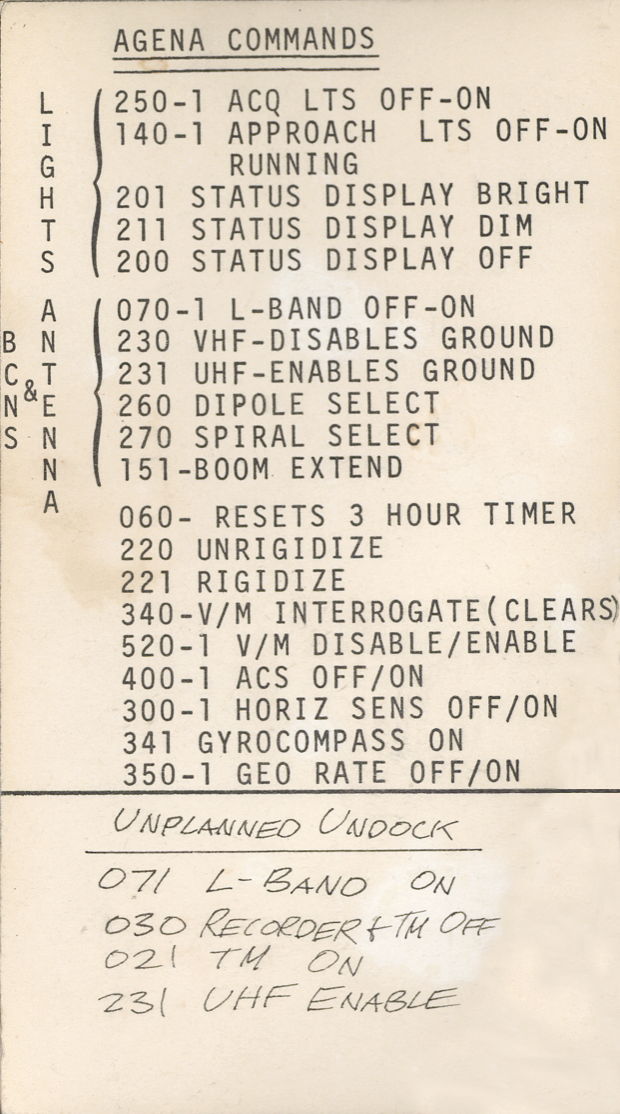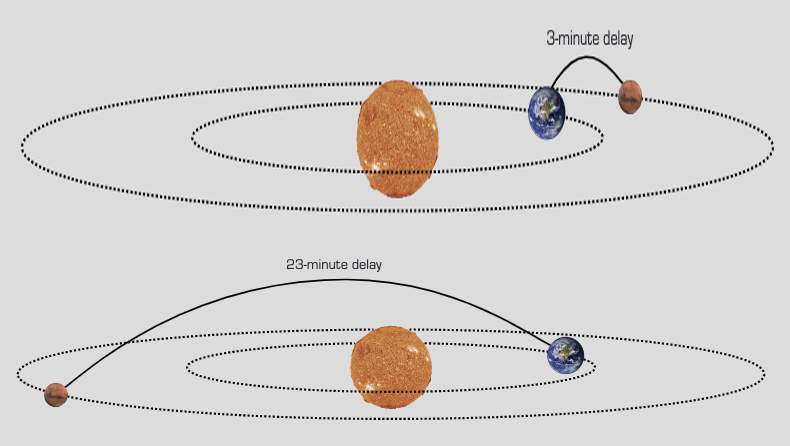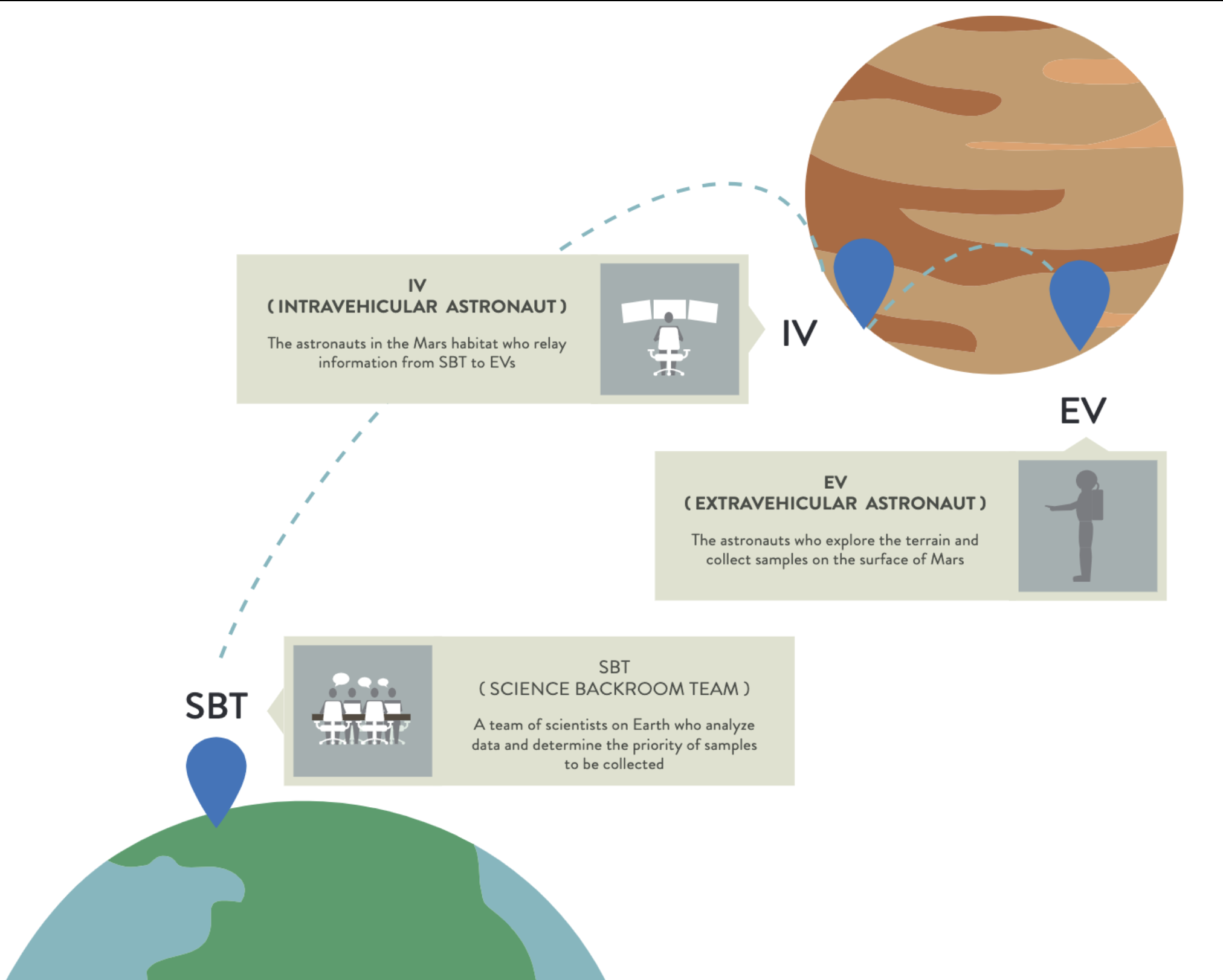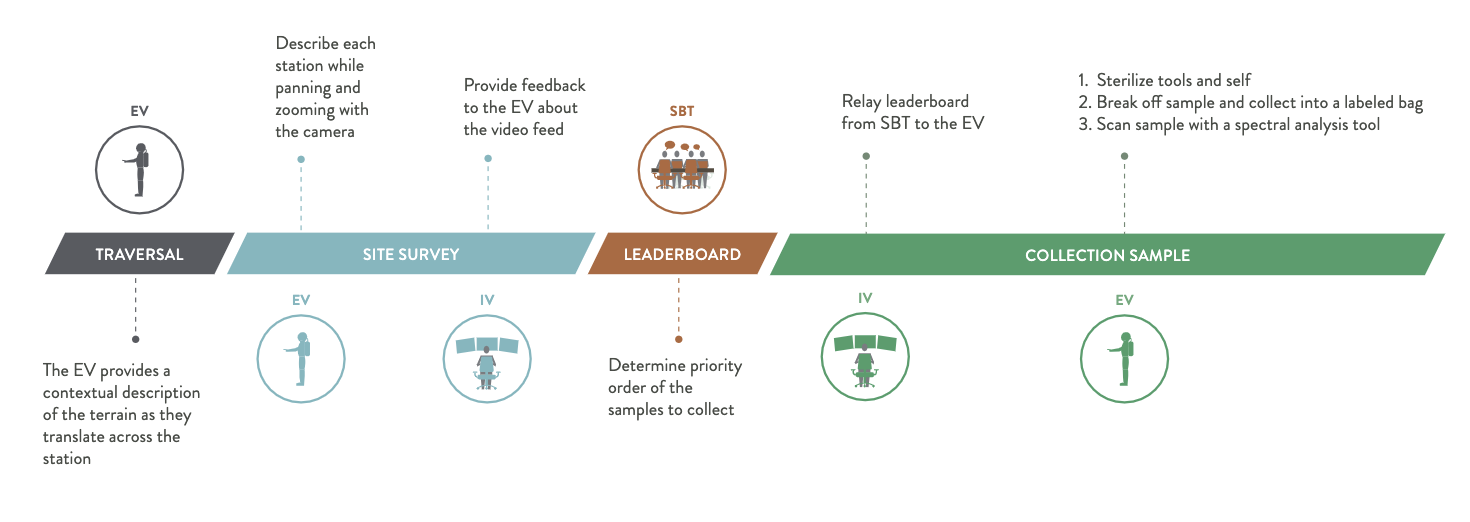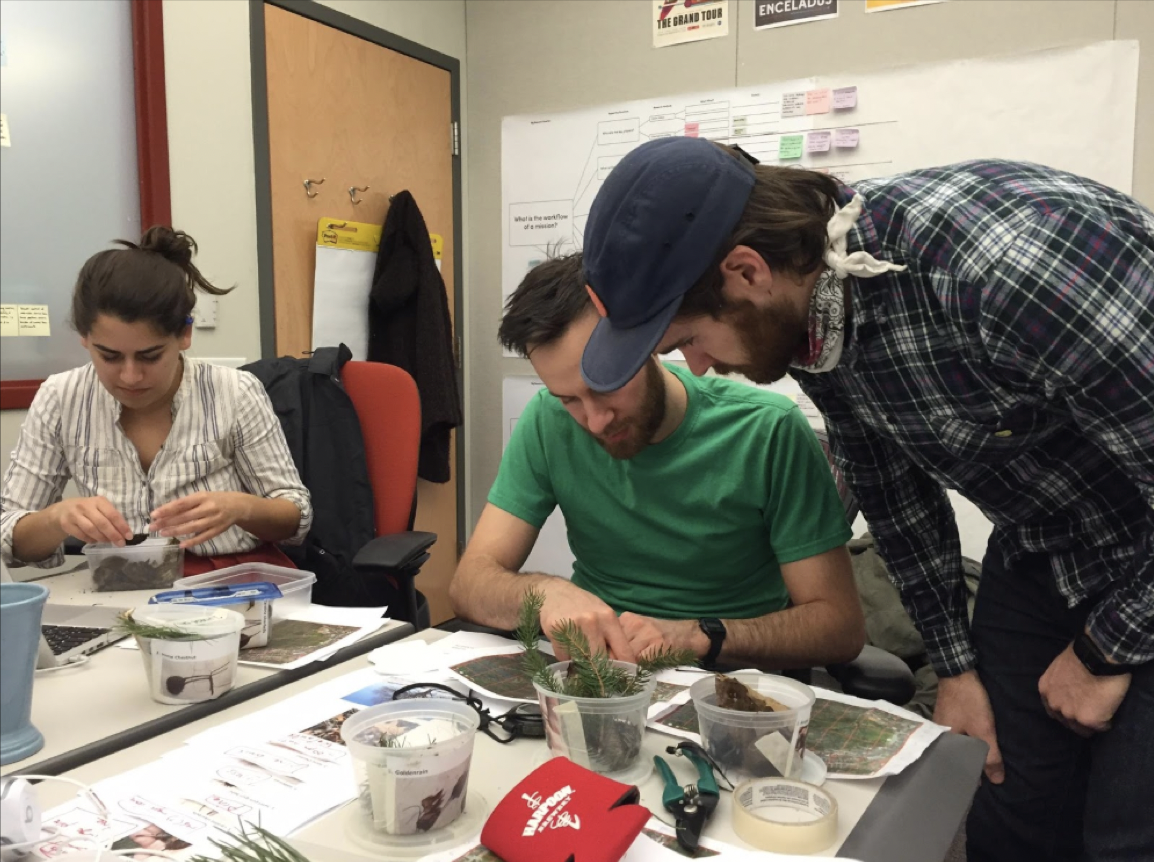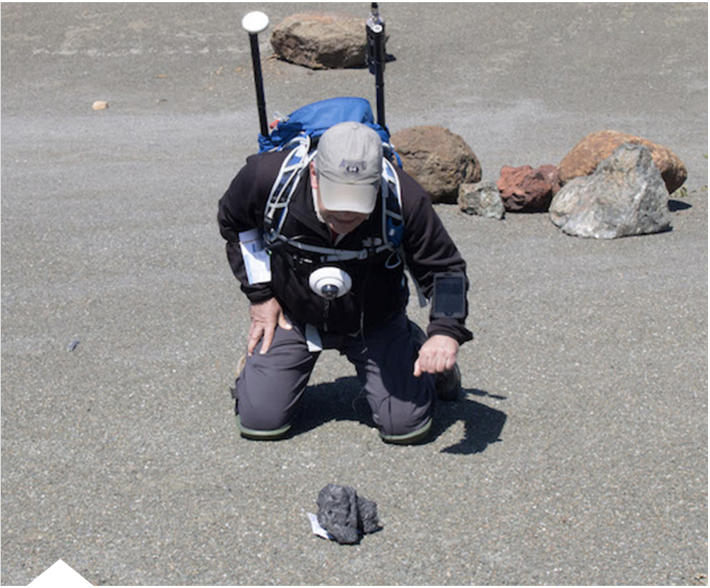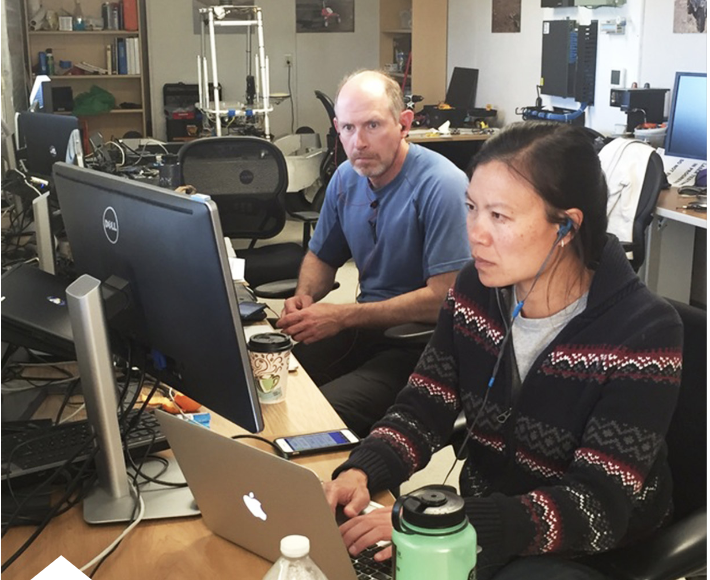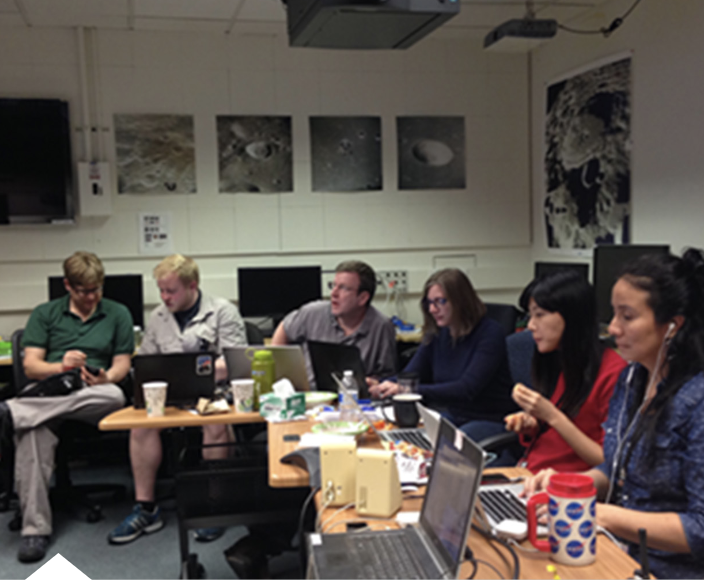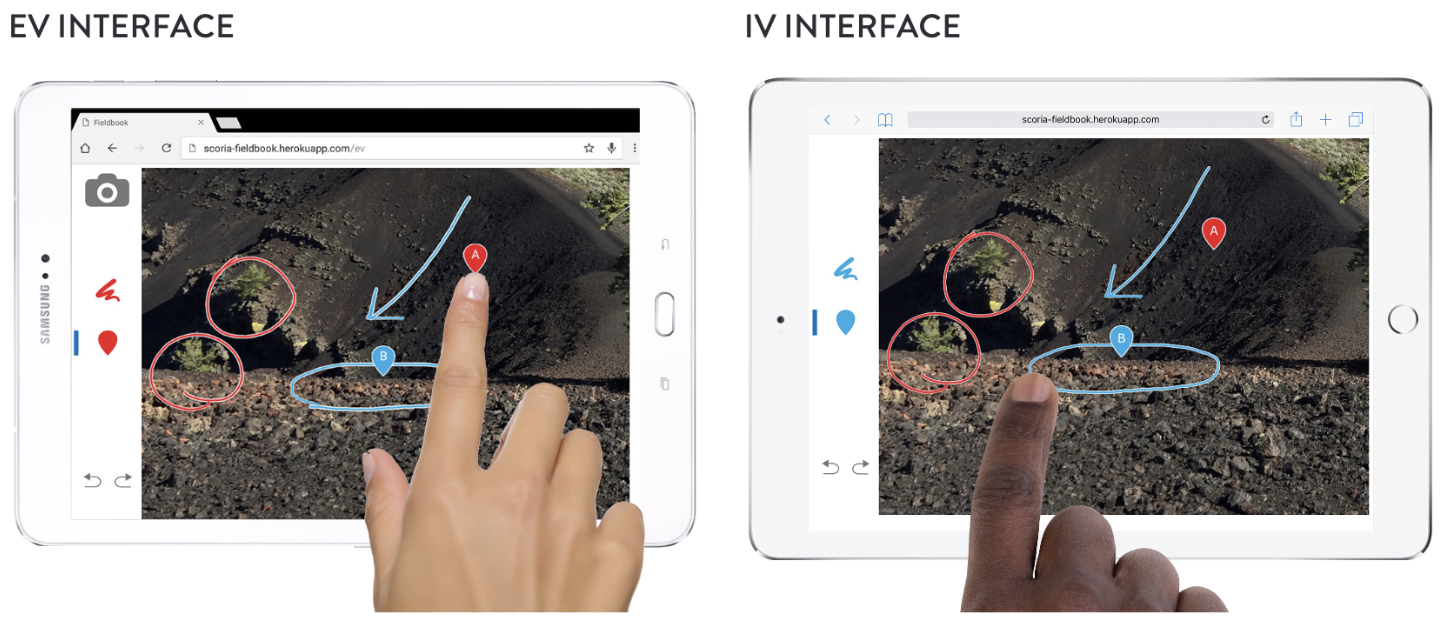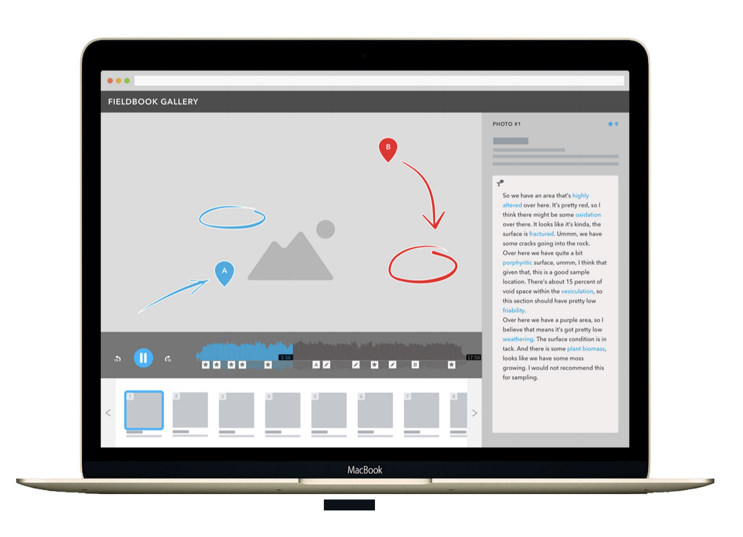NASA plans to send humans to Mars as early as the 2030s. Such a complex and expensive undertaking is justified by the fact that only humans have the unique set of abilities inherent to scientific exploration. A team of four graduate students from Carnegie Mellon’s Master of Human-Computer Interaction program took a user-centered design approach to identify breakdowns in current processes used in the practice and execution of extraplanetary exploration. Through a combination of secondary research, co-design, body storming, and ethnographic research including interviews and field studies, they found that current operational procedures constrain the human abilities of physical agility, adaptability, and perceptiveness. This effectively ignored the advantage of human agency over robotics. They used this insight to prototype a solution designed to streamline mission operations. This prototype was then tested against the goal of allowing team members to focus on leveraging their unique human abilities to deliver higher scientific return.
INTRODUCTION
Our Mission: Help Humans Explore Mars
In January 2016 the NASA Ames HCI group delivered a design prompt to Team Scoria, a capstone project team of four graduate students from Carnegie Mellon’s Master of Human-Computer Interaction program. The Ames stakeholders were interested in developing a tool to help guide humans as they perform geologic exploration on the Martian surface in future human-staffed missions to Mars. They pointed the capstone team to the current “cue card” system as inspiration — this system is comprised of wrist-based cue-cards that give astronauts step-by-step directions on how to complete tasks in space. The paper cue cards were used during the first trip to the moon, and they are still used today on the International Space Station. The Ames team was interested in how digitizing these cards might increase the amount of information they contained, thus increasing exploratory abilities (Carr, Schwartz, and Rosenberg, 2002).
Understanding the Case For Sending Humans To Mars
Although these cue cards are now used during space walks on the International Space Station, the last time they were used for extraplanetary exploration was in 1972 when Apollo 17, the last Apollo mission, landed on the moon. Since then various projects within NASA have been working toward the opportunity to continue this planetary science work either on the moon or further on to Mars. Projects of this type that presented the most relevance to the Scoria team’s work fell into two categories:
Rovers
NASA has been sending spacecraft to Mars since 1965 when it sent the Mariner 4 spacecraft to fly by the planet for the first close-up images of the Martian surface. Since then it has sent multiple rovers to perform a variety of tasks including: biology experiments searching for signs of life; mapping the entire Martian surface, atmosphere, and interior; conducting initial field geology; analyzing soil and rock samples for organic compounds. The current work of rovers on the Martian surface will help inform future human-staffed missions to the planet. Even now they are transmitting photographs and spectral images so that scientists on Earth can scout out the most promising locations for potential human exploration.
However, the precedence for sending humans to Mars is much different than the reasoning for the Apollo program. The competitive nature of the space race provided ample motivation for multiple landing missions. A mission to Mars, however, will be much more focused on scientific data collection from the start. As a result, NASA is investing for high-quality scientific return from studying the geology of the planet. There is also the added skepticism over sending humans to Mars when there is already so much to be learned from the rovers being sent there.
Team Scoria learned that while many scientific processes are better off being programmed into a standard and repeatable set of instructions, field geology is an exploratory science in which human perception and insight are great assets. In geology, priorities need to change on the fly and human instinct can inform those changes to obtain impactful results. Field geologists call this type of dynamic reprioritization “flexecution”. [Hodges and Schmitt, 2011] It is the human ability to quickly switch between execution and discovery, between set procedures and exploratory instinct. This is a key element in arguing for a human-staffed mission to Mars. In light of this, and as a human-centered design team, the Scoria members identified the preservation of these abilities as a guiding motivation during the design process.
Analog Missions
Sending humans into space is a monumental task, whether it be to the ISS, the moon, an asteroid, or Mars. To test protocol NASA divides the preparation into smaller problem spaces, explored through several analog missions on Earth. These analog missions practice for missions in space while also collecting valid scientific data here on Earth. (Lim, 2010). Examples include:
- NEEMO: based off the Florida Keys, this mission deploys aquanauts to an underwater habitat, utilizing buoyancy to simulate the gravitational reduction that astronauts face.
- D-RATS: This Arizona-based analog focused on testing space suit ergonomics, field equipment, communication protocols and the use of a vehicle in a desert habitat.
- HERA: This three-chamber habitat studies the effects of isolation and confinement on the mission members’ physical and mental health.
- BASALT: This team of geologists and engineers traverses Idaho and Hawaii lava fields to study the geology of basalt, a rock that is also found in abundance on Mars. They also simulate the future Martian team structure and communication protocols between team members.
Figure 1. Checklist card carried by Michael Collins during the Gemini 10 mission, July 18-21, 1966. On view at the National Air and Space Museum, Smithsonian Institution.
Defining The Users
In traditional human-centered design it is important to research and test products with users in their environment. This was obviously not possible for the Scoria team since there are currently no astronauts on Mars to observe or test with. As a result of this, the Ames group and Scoria team decided together that the best opportunity to design for Mars while also testing with users would be to partner with the BASALT analog mission team. The goal would be to create a tool for BASALT team members to use during analog mission execution. These missions already provided a rich environment in which to test new ideas around what technology, operations protocol, and team structure should be used in space exploration. By choosing to partner with the BASALT team the Ames and Scoria members were able to move away from speculative to applied design.
APPLYING ETHNOGRAPHIC RESEARCH PRACTICES TO HARD TO ACCESS USER BASES
Acknowledging Research Challenges
Overcoming the challenge of identifying the users only presented more challenges for the Scoria team. The team convened with its CMU and Ames advisors to plan out a research and design roadmap. In doing so the group identified the following challenges that would need to be addressed if the team wanted to adhere to user-centered design principles.
- Gaining access to users. The BASALT team was dispersed across the U.S. and would only come together twice for exercises during the capstone project timespan. These exercises provided the best opportunity for ethnographic field observation. However, the Scoria team would only have a few days each time to shadow the users. They were also limited on how close they could shadow the users, so as not to obstruct the BASALT team’s own data collection process during the exercise
- Misaligned timelines. The BASALT mission team was still in the early planning stages of its mission when the Scoria team kicked off research, which resulted in a misalignment of timelines. The Scoria team would not be able to conduct the foundational research of observing the team performing a mission in the field until months into the research process. The Scoria team would have to move forward with other methods of foundational research while maintaining flexibility so as to fold in research from the field work at a later point.
Preliminary Research on The Protocol and Tools of Human-Staffed Space Missions
To better understand the problem space the Scoria team performed an initial literature review and set of interviews with geologists and NASA scientists. The purpose of this early-stage research was to develop a comfortable familiarity with the domain. This broad approach provided a informational foundation upon which the team then built a more finely-scoped research roadmap.
The History And Utility Of Exploration Aids
The Scoria team first reviewed existing literature covering past NASA research on the various designs and prototypes of procedural aids (including cuff checklists, cue cards, and digital devices) (Hersch, 2009). This review helped the team develop a general understanding of why astronauts use cue cards for exploration and the history of their use. From there, they strategized a research plan to solve the remaining unanswered questions around how the design of cue cards impact mission operations. To answer these questions the team conducted a series of expert interviews with NASA scientists and engineers, all of whom had either designed or used some form of cue card exploration aid.
They talked to Trevor Graff, Project Manager of Advanced Explorations Group at Johnson Space Center. In helping plan NEEMO analog missions, Graff had found that the historic text-heavy design of NASA cue cards supported procedural execution, such as following safety protocol and ensuring correct documentation. However, they did a poor job of supporting exploration activities — he observed that crew members spent too much time focusing on the text of the cards and not enough time observing the environment around. He redesigned the cards to include visual and graphical information. This approach was adopted by other analog missions to help crew members with introductory scientific training complete complex scientific exploration (Graff, 2016).
They then talked to David Coan of Johnson Space Center Extravehicular Activity (EVA) Office and NEEMO 20 Aquanaut. Coan worked with ISS astronauts to design spacewalk support materials. He had used Graff’s redesigned cards himself as an aquanaut during the NEEMO 20 mission. He said the image-heavy design helped guide him in performing marine science, and that the biggest breakdowns were related to the human factors of dealing with laminated cards becoming slippery when used underwater.
Finally they talked to Darlene Lim, BASALT Principal Investigator and FINESSE analog mission Deputy Principal Investigator. Lim emphasized mission constraints, specifically communication delays. These delays can have a significant effect on the interactions between team members. To work amongst such constraints, Lim emphasized that mission teams must be able to balance competing priorities. To achieve this goal, she focused much of her time as BASALT PI working to ensure constant communication between all members of the analog mission.
Figure 2. At any given moment the delay for any communications to travel one-way between Mars and Earth is between a 3- and 23-minute delay. The BASALT team recreates this in analog missions by instituting a false delay of 15 minutes for communications between the Mars surface and Earth Mission Control teams. Illustration by Scoria team members.
The Operational Protocol Of A Mars Geologic Exploration Mission
Each NASA analog mission follows a specific set of operational protocols to meet the dual goals of replicating the constraints of an actual space mission and performing valid scientific observations. Protocol can differ depending on the mission focus. Via the literature review and interview with Lim, the Scoria team began to understand the complex procedural structure their users would be operating within. Anything the Scoria team designed would have to fit seamlessly within these pre-established and well-researched protocols.
The BASALT mission follows the same team structure and protocol that NASA intends to use for Mars explorations. The team structure is comprised of three main roles (outlined in Figure 3):
- Extravehicular (EV): The EV performs the “boots on the ground” role on Mars. They suit up and perform extravehicular traverses on the Martian surface to collect geological samples. They communicate with the Intravehicular crew member and refer to wrist-based cue cards to ensure they are meeting scientific goals.
- Intravehicular (IV): The IV has their “eyes on the ground” for the EV while on Mars. They stay inside the habitat on the Martian surface and communicate what the EV is seeing to the Science Backroom Team (SBT) and send feedback from the SBT to the EV on what samples to collect.
- Science Backroom Team (SBT): The SBT is a team of scientist experts on Earth who analyze data collected by the EV on Mars and make recommendations to the IV on what sites they should tell the EV to pursue and where to samples from.
Figure 3. The operational team setup of a Mars mission, to be recreated by the BASALT analog mission team. Illustration by Scoria team members.
The Scoria team also used information from the literature review and interviews to map out the timeline of a geological traverse, the part of the mission where the EV ventures outside of the habitat to collect samples. This helped the team identify the various goals of each user at various stages of their mission journey.
Figure 4. The timeline of a geologic traverse. Illustration by Scoria team members.
Workshopping and Bodystorming User Needs and Pain Points
The preliminary research established a firm foundation for the Scoria team to work from. By taking the time to map out the complexity of the problem space, the team was able to pinpoint next steps for the research. This involved understanding the users’ breakdowns and pain points. To achieve this, the Scoria team held a workshop with NASA analog mission geologist and performed a bodystorming exercise of the BASALT operations protocol.
Workshopping User Needs
The Scoria team visited Goddard Space Flight Center to meet with four planetary geologists who doubled as participants in NASA’s analog missions for Mars. Once again, the team had limited access to these users and were allotted exactly one hour with them. So, rather than a traditional face-to-face interview, Scoria members decided to run the meeting workshop-style with two co-creation exercises. This enabled them to collect a large amount of information from multiple people in a small amount of time.
Love/Hate Exercise: In this exercise, the geologists were asked to write out what they loved and hated most about doing geological field work.
- Themes of what the geologists loved included: the challenge of the science, the idea of exploration, and working with fun and intelligent teammates.
- Themes of what the geologists hated included: carrying clunky scientific instruments, novice field workers making poor safety decisions, teammates not being flexible, and getting interrupted in the middle of a task.
Fairy Godmother/ “Supersuit” Exercise: In this exercise the geologists were asked to imagine either a fairy godmother who could grant them any wish or to imagine their ideal field geology “supersuit” and sketch these on a piece of paper. Some examples of desires users expressed through these sketches included:
- The ability to reference sample data that has already been collected
- A glanceable status check of their teammates’ safety
- A way to offload the physical weight of instruments, samples, and tools
These exercises helped bring the most salient problems to the forefront quickly, making great use of all of the attendees’ time and leaving extra time for rich discussion.
Figure 5 (left). One geologist drew an augmented reality heads-up display to monitor team safety. Figure 6 (right). Another took a lower-tech solution and asked for a donkey to carry their equipment as their idea of a “fairy godmother”. Photos taken by Scoria team member.
Bodystorming A Mars Mission In Pittsburgh’s Frick Park
With three months of user research finished and a month left until they would get to observe the BASALT users in person, the Scoria team decided to put the knowledge they had collected into action and run a mock analog mission in Pittsburgh’s nearby Frick Park. Walking through the operational protocol themselves would help the team develop a closer understanding of it, thus better preparing them to strategically approach the upcoming in-person observation of the BASALT team.
This exercise also presented an opportunity for the Scoria team members to test out some hypotheses they had developed around user pain points. These hypotheses included concerns over team communications, human factors issues of balancing cue cards with other scientific equipment, and the EV being too distracted by operational protocol to engage in exploratory behavior.
Figure 7. The Scoria Team recruited classmates to run the bodystorming exercise. These participants created a grid system in their cue card maps to help streamline communications. Photo taken by Scoria team member.
The Scoria team designed the exercise to mimic as many of the BASALT team procedures as possible. Instead of Mars or a lava field on Earth, they studied a local park. They replaced the BASALT science objective of exploring microbial geology with the objective of characterizing the park’s tree life. The team then recreated the mission workflow by assigning team members to the three main roles in a traverse (EV, IV, and SBT) and by simulating a time delay of five minutes between the IV and the SBT. Using Google Earth for remote imaging data, they planned a path to have the EV explore through the park. They then identified samples of interest (such as acorns, pine cones, and types of trees) and equipped the EV with Tupperware to collect the samples.
During the exercise the EV was required to wear a cumbersome jacket and gloves to simulate the physical constraints of an astronaut suit and BASALT team equipment. All three team members were able to communicate with each other via phone connection, the EV wearing a headset on call to the IV. Meanwhile the IV was also on a separate call with the SBT with a 5-minute time delay for messages sent either way. Both the IV and the SBT had access to a computer and had Google Earth pulled up during the traverse to help track and direct the EV toward areas of interest in the park. The team also instituted a 40-minute time limit from the time the EV left the car to when they returned, recreating the constraint of having limited oxygen supply.
The Scoria team ran the exercise twice, once taking on the crew member roles themselves and once where they recruited classmates to be the crew members so they could observe. Running the exercise as crew members gave the Scoria team insight into the psyche of all three roles during a traverse. They particularly felt pressure related to the time constraints and communication delay.
Running the exercise as observers gave the Scoria team an opportunity to observe how the participants interacted with each other. They were specifically interested in how the participants notated their cue card materials with a grid pattern to better communicate location with each other.
Contextual Inquiry with the BASALT Team
At the end of May 2016, the Scoria team traveled to the Ames Research Center in Mountain View, California to observe NASA’s BASALT team practice a Mars traverse. BASALT used an outdoor space on the Ames campus called the “Mars yard” to simulate the hills, craters and rocks typically found on Martian terrain.
Since this was one of the few times the Scoria team would be able to observe a traverse in person, they strategized how to split up the team to observe areas of interest. This strategy was informed by prior research and the bodystorming exercise. The Scoria team identified the IV as a user of particular interest due to its role as a communicator to both the EV and SBT, and the pressure to communicate within a time delay. The team was also interested in how the EV balanced referencing cue card material with making exploratory observations in the form of vocal descriptions and photographs. Finally, the team was interested in how the SBT took in all of this information to make recommendations for where the EV should take a physical rock sample.
The Scoria team spent three days observing the BASALT team with emphasis on the above areas of interest. They took these observations back to Pittsburgh and started to combine them with prior research for a holistic analysis of the user journey of a BASALT mission.
The Scoria team used the affinity diagramming method to synthesize data across all of their research (Beyer and Holtzblatt, 1999). This allowed the team to deconstruct the data into single units of information and reconstruct the units into meaningful groups, through which themes emerged.
Figure 8. The EV observes a potential rock sample, getting on his knees to keep the rock in the frame of view of his chest camera for the IV and SBT teams. He is also wearing a heavy backpack full of networking equipment that both allows him to communicate with the IV and serves as a recreation of the physical constraints astronauts will endure on Mars.
Figure 9. In the IV station, two BASALT teammates keep an eye on the EV’s progress and communicate it to the SBT. Photos taken by Scoria team member.
Figure 10. The Science Backroom Team (SBT) awaits more information before they can determine the priority of samples to collect. Photo taken by Scoria team member.
RESEARCH FINDINGS
High-Level Finding: The Human Advantage Was Not Being Leveraged
NASA based its reasoning for sending humans to Mars on the differentiating qualities of physical agility, situational adaptability, and perceptual acuity. However, the Scoria team observed that these abilities were not being emphasized in the existing operations protocol for analog missions. The Scoria team proposed that without leveraging these human advantages, a human-staffed mission to Mars would be equivalent to sending the world’s most expensive extraplanetary robot to the planet.
Vocal Communications Needed to Be Streamlined
During a traverse, the Scoria team observed the EV conveying a thorough description of the landscape and target samples to the SBT so they could determine what sites to prioritize for sample collection. These descriptions were rich with perceptual and experiential subtleties that only a human could provide. However, observations of the BASALT team during contextual inquiry revealed that this critical information was being lost amongst operational communications.
Voice was the primary communication line being used between the EV and the IV. It was used to check if cameras were working, confirm whether the EV had the go-ahead to move to another site, and to convey how many and what type of samples had been collected. In the midst of all this, it was also used to convey the detailed scientific descriptions the SBT based mission priorities on. Amongst all the logistical communication, there was a risk of these significant descriptions going unnoticed.
Not only was cluttered voice communication a risk for losing perceptual data, it was a hindrance to the EV’s ability to focus on the task at hand. This was supported by earlier interviews with NASA scientists who expressed feeling cognitively overwhelmed with having to balance following operation protocol from the cue card with meeting science objectives. This also supported the high-level finding that without optimizing for the EV’s perceptual contributions to the mission, the operation would not be so different from sending another rover to Mars.
Opportunities:
For this research finding the Scoria team proposed the following opportunities:
- Operational updates could be communicated through other modalities, such as ambient displays informed by sensors.
- The word “standby” was used by BASALT team members when interrupted at inopportune moments. Non-vocal communication methods could be used to indicate availability instead.
- Filtering the EV voice communications could ensure only desired information was relayed to the science team. An EV might be more comfortable when verbalizing everything, but all of that information does not necessarily need to reach the science backroom.
The EV’s human experiential and perceptual data were not being captured in a permanent way
As demonstrated in the previous insight, experiential and perceptual descriptions provided the most uniquely human data. The Scoria team had observed and interviewed multiple experts putting in considerable effort to make cue cards to help prompt the EV for these descriptions. However, the Scoria team observed that these descriptions were often haphazardly and hurriedly transcribed by the BASALT science backroom and ultimately not referred to at all during the traverse.
The Scoria team found that human observations provided two distinct types of data. Perceptual data came from the EV’s direct descriptions of their surroundings. This was mainly informed by visuals, but other senses helped inform this as well. Meanwhile, experiential data came from the EV’s emotion and tone during their descriptions. This data, if transmitted effectively, helped the SBT empathize with the EV and better understand the importance and magnitude of observations.
The hurried attempts at voice transcription in the science backroom were low in quality and not accessible in a way that made the information salient to team members. As a result, during critical decision points, such as determining the leaderboard of what sites to sample during a traverse, the backroom ended up defaulting to image data. This essentially defeated the purpose of human exploration; image data is something that Mars robots are already capable of providing to scientists. However, capturing human perceptual and experiential data is very difficult. It is not directly quantifiable, it varies from person to person, and it requires a highly effective shared vocabulary.
Opportunities:
For this research finding the Scoria team proposed the following opportunities:
- Finding and utilizing methods of capturing human perceptual data would better inform the science backroom. The first step should be building and mastering a strong shared vocabulary that goes beyond technical detail and description.
- The EV job and protocol could involve much more than pictures and scripted descriptions. It would make a difference to capture that “wow” factor that humans feel when seeing something in person.
Crew members assumed knowledge and understanding, resulting in varying mental models
The inherent setup of analog practice missions involves a team of professionals with a very diverse set of expertise. Transference of this knowledge amongst teammates is critical to a successful mission. The Scoria team observed some knowledge sharing at the BASALT practice mission, but there were many instances in which team members experienced misunderstandings of basic, foundational information.
As the Scoria team found early on from interviews, diverse teams of experts develop problems of assumed knowledge. With a high level of respect for one another’s intelligence, few people think to stop and explain the rationale behind certain decisions, while others do not think to stop and question them.
The Scoria team observed this phenomenon during the BASALT practice mission. For example, crew members had several discussions aimed at clarifying whether a geological exploration site was five meters in diameter or five meters in radius. The team also observed considerable confusion surrounding the required amount of rock sample to be collected, due to subjective and culturally dependent metrics such as “baseball-sized” and “softball-sized”.
While these discrepancies in understanding were seemingly small, they could have potential consequences. If one of these misunderstandings occurred during a time-sensitive traverse, an EV could easily collect an insufficient amount of sample, rendering it completely useless for proper scientific analysis. Moreover, the human ability to “flexecute” during a traverse could really only occur with a deep understanding of the scientific goals. Without this understanding, the EV would struggle to adapt to the new environment.
Opportunities:
For this research finding the Scoria team proposed the following opportunities:
- Having common visuals (diagrams, charts, etc.) during an EVA could make sure everyone estalibhses a common frame of reference for complex tasks.
- Co-creation of processes and decision points fosters internalization of the rationale behind those decisions. Having the EV involved throughout mission planning could help their ability to “flexecute”.
Mission aids were beneficial to the EV in “Execution Mode” but a hindrance in “Discovery Mode”
Mission aids included items to guide the EV in a formulaic way, such as cue cards, checklists, and GPS trackers. The Scoria team observed that they were appropriate tools for an EV to use in “execution mode”, when the goal was to complete a task efficiently, much like a robot. However, the Scoria team observed that team members in the EV role felt the need to follow mission aids to perfection. This anxiety prevented the EV from engaging in “discovery mode”, when the goal was to observe their surroundings for areas of interest.
The Scoria team learned that when an execution-oriented aid was put in front of someone, the person tended to follow it with precision, even when dealing with a discovery-oriented activity. During one of the BASALT traverses, the EV felt the need to follow a guided walking path with great accuracy even though it was merely a suggestion. He might have missed an interesting rock on the side as a result of putting his focus to staying on the path.
In addition, the majority of all mission aids designed for the analog missions were designed for “execution mode” only. For example, the BASALT team built a guideline on how to approach unplanned sites of interest. However, even this discovery-oriented information was presented as an execution-style cue card. The Scoria team conceded that “discovery mode” aids might be more difficult to design due to their less prescriptive nature. But since “flexecution” is such an important human attribute, the absence of these aids presented a rich opportunity for future designs.
Opportunities:
For this research finding the Scoria team proposed the following opportunities:
- The time for “execution mode” and the time for “discovery mode” should be clearly distinguished. Designing mission aids to clearly separate the two modes could help greatly. Current protocol tends to default to designing for “execution mode” only.
- There must be a great trust of the EV’s decisions. The EV needs to know that the team is confidently behind them when it is time to explore.
PROTOTYPE DESIGN AND TESTING
Ideation through rapid iteration
After presenting their research to the NASA HCI group and the BASALT team, the Scoria team orchestrated a visioning session with our users. They guided the group through an ideation exercise in which small teams generated ideas for design solutions via sticky note and paper prototypes. By the end of the exercise, the Scoria team and users had collectively generated just over 100 ideas. The Scoria team then grouped these ideas into eight high-level themes. They created a more detailed paper prototype for each theme that they then concept tested with their BASALT users.
The team decided to focus on improving the capture of the scientific observations coming from the EV. This use case was generated in direct response to the the second opportunity space that emerged in research regarding the experiential and perceptual, i.e. uniquely human, data being lost. A design to capture geologic observations in a clear and concise format would allow the science backroom team to easily reference the information while determining the leaderboard of sample priorities. Furthermore, storing the observations in a standardized, searchable database would allow for easy data aggregation across multiple sites during future analysis.
Once the Scoria team had their design space scoped down to capturing the EV’s scientific observations, they moved forward with developing a single design to address that specific scenario. They named this design “Fieldbook” in reference to the yellow notebooks geologists take into the field with them to write down notes and observations.
The team’s initial design solution consisted of a tablet-based interface for the EV to carry into the field, and a desktop interface for the IV inside the habitat. The EV was able to take photos with the tablet and touch a specific point on the photo, when this happened the same point appeared in real-time on the IV interface. This interaction allowed the EV to clearly indicate each specific point of interest to which their subsequent observations pertained.
Each time the EV indicated a point of interest on the photo, the IV was provided with a form to capture the vocal descriptions that followed. Since the EV typically provided similar sets of information for each point of interest (color, surface condition, texture), the form was designed around these characteristics to allow the IV to quickly input commonly collected data. Standardizing the data input in this fashion would allow the IV to send an organized and concise data packet to the science team for real-time decision making.
Figure 11. The initial EV and IV designs for Fieldbook. Mocks by scoria team members.
User Testing Results in Design Pivot
The Scoria team moved forward with building an interactive prototype of their initial design to test with members of the BASALT team in the field. In July the Scoria research team met the BASALT team at the Craters of the Moon National Monument in Arco, Idaho. The BASALT team chose Craters of the Moon as a mission deployment site because of its similarity to the terrain on Mars. As the most recent eruption site in the continental U.S., with volcanic activity occurring as recent as 2,000 years ago, this lava terrain was the closest that the BASALT team could get to practicing field geology in an actual Martian environment.
During this testing the research team uncovered multiple insights for how to improve the design. The greatest insight was the desire for two-way annotation between the EV and IV in the interface. The Scoria team had intended the ability to annotate the photo with a dot to be an EV-only feature. However, the one-way constraint had not yet been added into the code at the time of the Idaho trip. During testing, the researcher noticed that IV users started using the tool to draw the EV’s attention to elements that the EV had not noticed elsewhere on the photo. This accidental two-way pointing interaction resulted in rich discussion between the IV and EV and prompted the EV to explore the site further. This observation directly mapped to the team’s goal to design for EV exploration over pure execution. It was concrete evidence that fostering a focused, exploration-oriented conversation between the EV and the IV can result in new discoveries.
After discovering its value in the field, the Scoria team pivoted to fully supported the two-way pointing interaction for both the EV and the IV. They also implemented a drawing tool for both EV/IV UIs in response to the feedback BASALT users gave about wanting to be able to circle areas and draw arrows. Although these changes occurred late in the team’s design cycle, they had maintained enough flexibility to incorporate the feedback knowing that the opportunity to test in the field would provide valuable data despite its inconvenient timing.
Final Design: Fieldbook
After implementing changes in response to the BASALT user feedback, the Scoria team created a final prototype for the Fieldbook tool. Its core element was Fieldbook Canvas, a working two-part web application designed to capture geological observations during a traverse. This two-way image annotation tool was designed to bring the EV and IV into a shared mental space, equipping them to explore the Martian terrain together by drawing each other’s attention to areas of interest. The EV was equipped with a belt and attachable tablet with which to take photos and annotate them on the Fieldbook Canvas app. The IV was able to pull the app up on their workstation inside the habitat.
Figure 12. Final designs for the Fieldbook Canvas EV and IV interfaces. Both are able to drop pinpoints on areas of interest and use the draw function to circle areas and draw arrows. Design by Scoria team members.
The team also designed a concept and wireframe mocks for a second application they called Fieldbook Gallery. The Gallery tool was designed for the SBT to quickly parse the incoming images, annotations, and recordings from the EV and IV in order to make quick, informed decisions about sample priorities. It included incremental audio navigation controls to skip behind or ahead in the audio, the ability to add markers in an audio file to return to, and speech-to-text transcription of the audio files. It would also connect snippets of audio to a specific photo.
Together, Fieldbook Canvas and Gallery met the user needs exhibited in the overall research insights in multiple ways. Primarily, the real-time annotation of Fieldbook Canvas allowed the EV and IV to collaborate closely with each other during the exploration process. The audio/visual data capture elements of Fieldbook Gallery prevented the need for the IV to take such rigorous notes for the SBT and instead freed them up to engage more with the EV on exploration tasks.
Figure 13. Final mock exploration for the Fieldbook Gallery tool for the Science Backroom Team (SBT). The tool would provide a view of each photo alongside the transcribed text that was recorded by the EV and IV while they were describing it as well as the ability to
CONCLUSION
Design Opportunities for Increasing Human Explorers’ Autonomy In a Mars Mission
However, the culmination of the Scoria team’s research showed that current simulations of Mars geology work were not leveraging the advantage of human agency. Communication lines were chaotic, perceptual data were not captured, miscommunication resulted in inefficiencies, and all tools were made for procedural execution rather than in true support of the exploration-oriented mission.
The Scoria team took a user-centered design approach to prototype a product that addressed these breakdowns. This resulted in a two-part web application that fostered an exploration-oriented conversation between the crew on Mars and delivered a digestible data package to the science team on Earth to support quick and efficient realignment of priorities in real-time. The product could be implemented to streamline the operations of an exploration-based mission to make room for the inherent advantage of a human crew, ultimately resulting in increased scientific return and increased autonomy for the crew members.
REFERENCES CITED
Beyer, Hugh and Karen Holtzblatt. “Contextual Design.” Vol. 6 of Interactions. First published 1999.
Carr, Christopher E., Steven J. Schwartz and Ilia Rosenberg. “A Wearable Computer to Support Astronaut Extravehicular Activity.” Proceedings of the 6th International Symposium on Wearable Computers. 2002.
Graff, Trevor, et al. “NEEMO 20: Science Training, Operations, and Tool Development.” (n.d.).
Hersch, Matthew H. “Checklist: The secret life of Apollo’s ‘fourth crewmember’.” The Editorial Board of the Sociological Review (2009).
Hodges, K. V. and H. H. Schmitt. “A new paradigm for advanced planetary field geology developed through analog experiments on Earth.” The Geological Society of America Special Papers 483 (2011).
Lim, Darlene S.S., et al. “Scientific field training for human planetary exploration.” Planetary and Space Science 58.6 (2010): 920-930.

